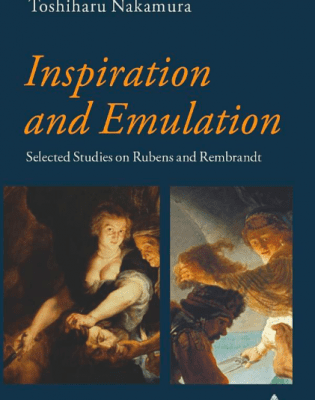Although the literature on Rubens and Rembrandt is prolific, most publications arise from scholarship conducted in North America or Europe. It is thus a pleasure to welcome this book of essays by Toshiharu Nakamura, professor of art history in the Graduate School of Letters at Kyoto University, who passed away in 2018. Edited by his colleague Kayo Hirakawa, the volume was compiled before Nakamura’s death and was published posthumously. It brings together seven essays originally published between 1997 and 2016 in Japanese journals and exhibition catalogues. They comprise three chapters on Rubens, three on Rembrandt, and one on Frans Hals, but the real hero of the series is Rubens, whose impact is addressed throughout. While originally published in English, three of the essays were revised by Nakamura for this publication, and most had been difficult to access outside Japan.
In the first chapter, Nakamura examines Rubens’s workshop practice. He thoughtfully explores the tensions between a studio assistant’s mandate to act as an “invisible hand,” contributing seamlessly to the master’s compositions, and the inevitable manifestation of distinctive talent, as demonstrated in the work of Anthony van Dyck. Despite reliance on assistants, Rubens’s pride in his own abilities shines through, as in his assertion to Sir Dudley Carleton that his mastery of animal painting surpassed that of Frans Snyders. The second essay, previously circulated only in Japan, focuses on Pausias and Glycera (c. 1615, Sarasota, Ringling Museum), painted by several hands that may include Osaias Beert and Rubens himself, as a test case for the practice of collaboration between Rubens and other established masters. Nakamura argues that Rubens interprets the rare theme of Pausius’s love for Glycera, who made and sold wreaths of flowers, to assert both the value of still life painting and the superiority of art over nature. The third chapter situates Rubens’s oil sketches within a tradition established in the Italian Renaissance, proposing that Rubens’s early experiences of competing for commissions from the Oratorians and other patrons in Rome instilled in him the value of expressive, richly colored modelli for attracting lucrative commissions.
The first chapter on Rembrandt discusses the innovative features of the early Andromeda (c. 1630, The Hague, Mauritshuis), showing that the classicist critique levelled at Rembrandt’s realistic representation of the female nude had much in common with earlier critiques of Caravaggio. Although Rubens’s version of the theme, painted a few years later, is often contrasted with Rembrandt’s, Nakamura notes that Rubens, too, was concerned with naturalistic representation of anatomy and emotion. The second essay on Rembrandt may be the most familiar to Western readers, since it first appeared in the proceedings of the international conference on Rembrandt and Dutch history painting held in Tokyo in 2003. Here, Nakamura analyzes Rembrandt’s dialogue with pictorial antecedents, especially Rubens, in The Blinding of Samson (1635, Frankfurt am Main, Städel Museum). Nakamura interprets the Frankfurt painting as the culmination of a project that began much earlier, with variants on the Samson and Delilah theme painted by Rembrandt and Lievens as young artists in Leiden. Thirdly, Nakamura explores Rembrandt’s teaching methods with a focus on narrative imagery. He compares compositions by Rembrandt with variants by pupils and analyzes Rembrandt’s corrections to students’ drawings as lessons in how to clarify the drama and emotional logic of the scene. He observes that in some cases, Rembrandt’s work might be a response to the pupil’s version rather than the reverse, a theme that deserves further investigation.
The seventh and most recent essay, first published in Kyoto Studies in Art History in 2016, examines the tronie-like genre paintings of Frans Hals. Here again, an underlying theme is the impact of Flemish models: Nakamura emphasizes the importance of Hals’s trip to Antwerp in 1616 and considers head studies by Frans Floris and Rubens he might have seen there. He suggests that Hals took from Rubens not only expressive brushwork but also the individuation of the model painted from life, a departure from Floris’s more generalized types. An intriguing feature in common is the adoption of unconventional poses, such as a sharp upward glance, that suggest a narrative context. While Rubens often chose such poses with larger historical compositions already in mind, Hals’s independent tronies invite the viewer to imagine a context that is only implied.
Solidly grounded in primary texts and recent research by scholars in North America and Europe, each essay offers subtle insights into creative inspiration and rivalry. Lucidly written and cogently argued, these studies could usefully be assigned as reading for advanced undergraduate and graduate students. Thus, it is fortunate that this book is available in both print and electronic versions.
Stephanie S. Dickey
Queen’s University
